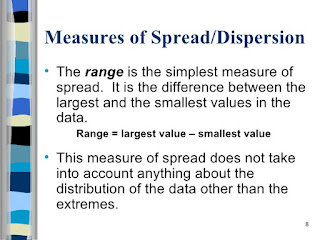Measures
of variability are also called the measures of spread or dispersion. It lets
the researcher know how scattered the scores are from their central tendency.
For example,
if a group is homogeneous (containing individuals of nearly the same ability),
most of its scores will fall around the same point on the scale; therefore, the
range will be relatively short and the variability will be small.
But, if
the group is heterogeneous (having individuals of widely differing capacities),
scores will be strung out from high to low; thus, the range will be relatively
wide and the variability will be large.
In
order to indicate the variability or dispersion, the following four measures
have been devised. These are:
1. Range: It is
the simplest form of measures of variability. It is the difference between the highest
and the lowest scores in a distribution. Range is the crudest form of
variability as it considers the extremes scores only. It is not a stable statistic
(unreliable) because its value can differ from sample to sample drawn from the
same population.
2. Quartile
Deviation: The quartile deviation (generally represented by “Q”) is
one-half of the scale distance between the third quartile (75th
percentile) and the first quartile (25th percentile) in a frequency
distribution. First quartile is a point below which 25 percent of the scores
lie, while the third quartile refers to the point below which 75 percent of the
scores lie. Quartile Deviation (QD) is preferred when scores are widely dispersed
or scattered.
3. Average
Deviation: It is also called “Mean
Deviation”. It refers to the average of deviation of all scores from their
mean. It does not consider signs (negative and positive) of the scores; that
is, all deviation whether plus or minus are treated as positive.
4. Standard
Deviation: Standard Deviation (SD) is the square root of variance. It
is the most stable form of measures of variability. It is employed in
experimental work. Variance refers to the average of the square deviations of
the measures or scores from their mean. Standard Deviation (SD) is used when
scores are not widely dispersed or scattered.



